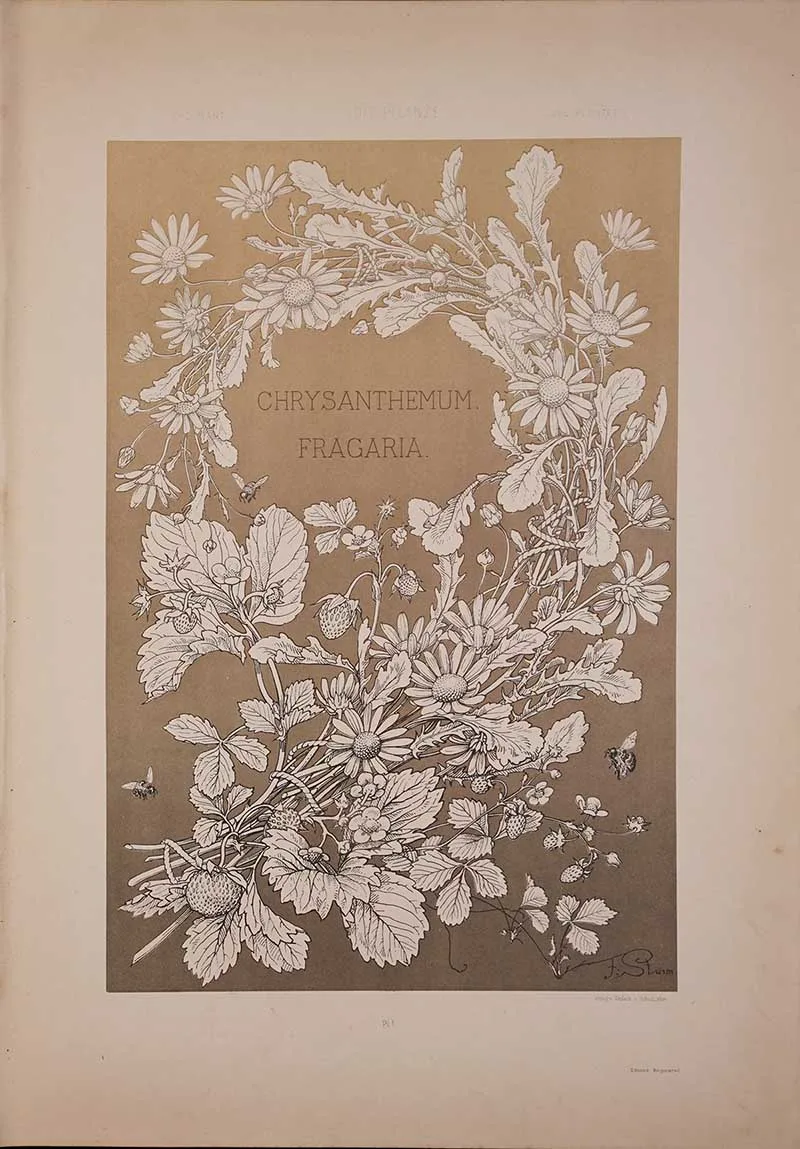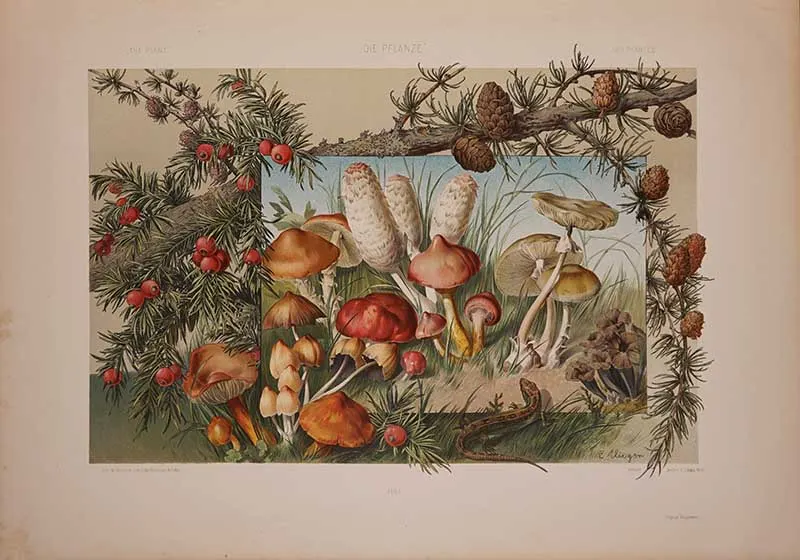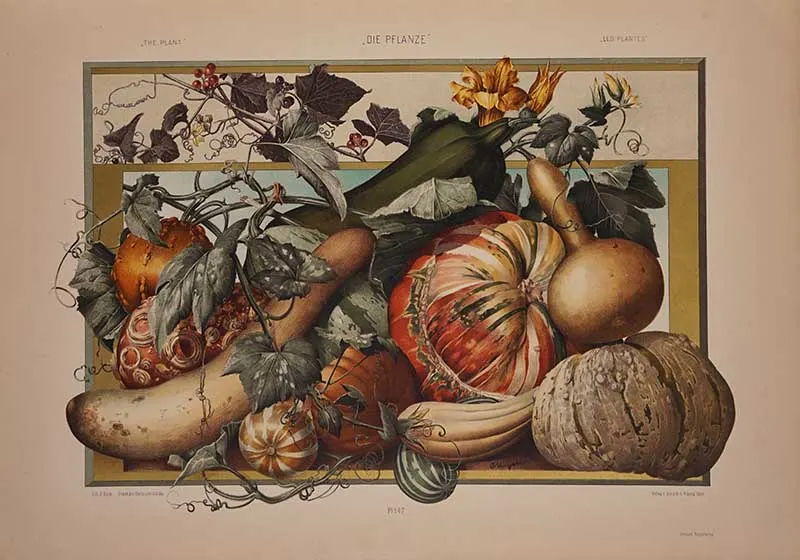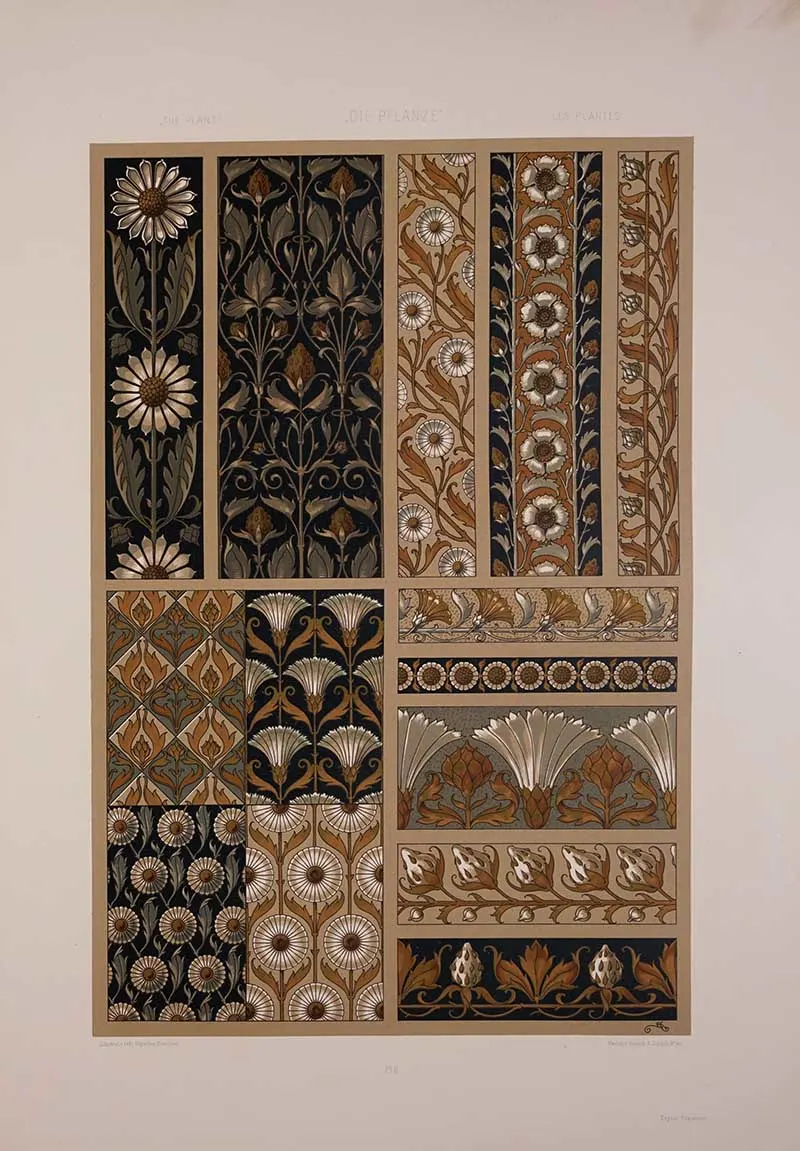Inside: A collection of vintage plant art plates from the book “Die Pflanze in Kunst und Gewerbe” by Martin Gerlach. All are in the Public Domain and free to download.
Step into the enchanting world of plant art with Martin Gerlach’s “Die Pflanze in Kunst und Gewerbe“. Translates as The Plant in Arts and Craft 1886. Gerlach’s unique and innovative approach to exploring the relationship between plants and art is fascinating.
The book is a two-volume work that explores the relationship between plants and art. One of the most fascinating aspects is the exquisite beauty of the plant art plates featured in the book.
Martin Gerlach’s meticulous attention to detail and artistic skill is evident in the stunning illustrations accompanying his writing. The images showcase a rich array of plant motifs rendered in intricate detail and vibrant colours.
Several artists contributed the plant art to both books their signitures are on each print.
Martin Gerlach and “Die Pflanze in Kunst und Gewerbe“
Martin Gerlach (1846-1918) was an Austrian artist, illustrator, and writer who significantly contributed to art, design, and botanical studies.
Gerlach was known for his innovative approach to exploring the relationship between plants and art. His most famous work is “Die Pflanze in Kunst und Gewerbe.” Gerlach’s artistic style featured attention to detail and vibrant use of colour. The book showcased both his artistic skill and botanical knowledge.
Gerlach’s Plant Art book was groundbreaking as it was one of the first to fully explore the intersection of botany, art, and design. He combined his knowledge of art history, botany, and aesthetics to provide a unique perspective on the relationship between plants and artistic expression.
Gerlach’s book influenced the Arts and Crafts movement, particularly the work of William Morris. Its emphasis on the beauty and symbolic significance of plant motifs in art and applied arts resonated deeply with the movement’s ideals of celebrating nature, beauty, and craftsmanship.
Gerlach’s approach aligned with William Morris’s own artistic and design sensibilities, and he drew inspiration from Gerlach’s ideas in his textile designs, wallpapers, and other decorative arts.
The book is still influential today.
Anton Seder
Anton Seder was a notable artist and illustrator who contributed significantly to the book; he provided the illustrations for the book’s second volume, which focused on plant motifs’ scientific and botanical aspects.
Seder’s illustrations were known for their accuracy and attention to detail, depicting various plant species scientifically and artistically.

How To Download The Vintage Plant Art
I have selected thirty-two of my favourite art plates from both book volumes. There are many more beautiful plates to choose from, and you can find them at the library of The Clark Art Institute.
To download the botanical art plate, you want, click on the title above the plate. A higher-resolution image will open in a new window. Click on that image to save or print it.
All of the prints are in the Public Domain and therefore Copy-right free.
Botanical Art Plates From Volume 1
Volume 1: The first volume of “Die Pflanze in Kunst und Gewerbe” is titled “Geschichte der Pflanze in der abendländischen Kunst” (History of the Plant in Western Art). This volume focuses on the historical depiction of plants in art.
Print 1: Chrysanthemum fragaria
A beautiful illustration of bees on a strawberry plant.

Print 2: Narcissus, Tulip & Crocus
This vintage plant art is of three flowers, narcissus, tulip and crocus with a few beetles thrown in.

Print 3: Colour Lithograph of Narcissus, Tulip & Crocus
A colour lithograph of the same flowers above in a more artistic style with mice. These flowers remind me of the Dutch Masters still life paintings.

A photolithograph of a squirrel amongst oak leaves feasting on hazelnuts.

A colourful vintage plant art lithograph of passionflowers.

A painting of a Japanese fan in a gingko tree.
A painted Japanese fan amongst gingko leaves. Ginkgo leaves are a common motif in Japanese art, literature, and poetry, and are often used in traditional Japanese tea ceremonies and other cultural practices.

A photozincographic vintage plant art print of Artichokes.

Print 8: Larch, Mushrooms and Yew
A woodland plant art print inlcuding a collection of colourful mushroom and fungi.

A photozincograph of various pine cones.

These white lilies look like they are growing in a chruch yard. This is a wood cut art print.

A stylised colour litograph by Anton Seder of a pineapple, pepers and corn.

Print 12: Pumpkins, Squashes & Gourds
This colour lithograph looks like a autumn harvest horde of pumpkins, squashes and gourds.

A coloured lithograh vintage art print of a fairy amongst the clematis.

A lithograph of a garden poppy in various states of bloom and poppy seed heads.

Colour lithograph of donkey and weather thistles.

Vintage Plant Art Plates From Volume 2
The second volume of “Die Pflanze in Kunst und Gewerbe” is titled “Die Pflanze in der angewandten Kunst” (The Plant in Applied Art) and focuses on the use of plant motifs in applied arts and crafts. Gerlach examines the artistic and aesthetic aspects of using plant motifs in applied art, including their role in ornamentation, design principles, and craftsmanship.

Donkey and weather thistles painted by Anton Seder as stylised ornamental motives.
These art designs share similarities with the work of Maurice Pillard Verneuil in their focus on plant motifs in art, but they are distinct in their approaches and influences.
Gerlach’s work had a more scholarly and analytical focus, emphasising the relationship between plants and art in a broader cultural context. On the other hand, Verneuil was known for his avant-garde and decorative approach to plant motifs, which was more closely associated with the Art Nouveau movement.

Animals and plants are combined in this motive painting of Kohlrabi by Anton Seder. Vernuil also did this later with his Art Nouveau animal patterns.

Print 18: Assorted Woodland Flowers
The flower motives feature here include, cowslip, liverwort, violet and lily of the valley.

Anton Sedar’s vintage plant art of various woodland leaves, including maple, willow, birch, basswood, mistletoe, beech, and holly.

Print 20: Strawberry & Daisy Patterns
Border patterns and designs featuring strawberry plants and daisies.


Print 22: Crocus, Tulip & Narcissus Motives
Colourful ornamental flower motives of crocus’s, tulips and narcissuses.

Print 23: Stag Skull and Woodland Leaves
Garlands of oak leaves and hazelnut leaves around a stag skull. This is a vintage collotype botany print.

Print 24: Passionflower & Christ
The unique features of the passionflower have been said to represent elements of the crucifixion story of Jesus Christ, making it a significant plant in Christian art and religious interpretation.

Print 25: Cowslip, liverwort, violet and lily of the valley
Ornamental motive of the woodland flowers of cowslip, liverwort, violet and lily of the valley.

Lithographic vintage plant art of palm trees.

Print 27: Mushrooms and Pine cones
Ornamental patterns made up of assorted mushrooms and pine cones.

A pair of owls perched in a pine tree.

Print 29: Daruta, arum lilly and blessed thistle.

Vintage ornamental floral patterns based on the plants’ sunflower, ibis, clover, chicory, larkspur, foxglove, salsify, and meadow rue.
Check out this how to draw a sunflower tutorial.

Stylized garden poppy plant art print.

Pattern designs of ferns and gentians.

Other Plant Insipiration Books
Whether you’re an artist seeking inspiration or a home decorator looking for unique and captivating decor, the patterns and prints in “Die Pflanze in Kunst und Gewerbe” are a delight. Let the botanical wonders captured in Gerlach’s book enhance your creative endeavours or add a touch of natural beauty to your home decor!
Other vintage plant art and ornamentals books you should also check out are;
If you fancy, you can Buy Me A Coffee Here.
